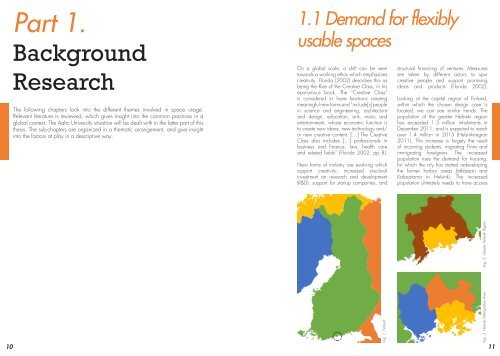View/Open - Aaltodoc
View/Open - Aaltodoc
View/Open - Aaltodoc
Create successful ePaper yourself
Turn your PDF publications into a flip-book with our unique Google optimized e-Paper software.
Part 1.<br />
Background<br />
1.1 Demand for flexibly<br />
usable spaces<br />
Research<br />
The following chapters look into the different themes involved in space usage.<br />
Relevant literature is reviewed, which gives insight into the common practices in a<br />
global context. The Aalto University situation will be dealt with in the latter part of this<br />
thesis. The sub-chapters are organized in a thematic arrangement, and give insight<br />
into the factors at play in a descriptive way.<br />
On a global scale, a shift can be seen<br />
towards a working ethos which emphasizes<br />
creativity. Florida (2002) describes this as<br />
being the Rise of the Creative Class, in his<br />
eponymous book. The “Creative Class”<br />
is considered to have functions creating<br />
meaningful new forms and “include[s] people<br />
in science and engineering, architecture<br />
and design, education, arts, music and<br />
entertainment, whose economic function is<br />
to create new ideas, new technology and/<br />
or new creative content. […] The Creative<br />
Class also includes […] professionals in<br />
business and finance, law, health care<br />
and related fields” (Florida 2002, pp 8).<br />
New forms of industry are evolving which<br />
support creativity: increased structural<br />
investment on research and development<br />
(R&D), support for startup companies, and<br />
structural financing of ventures. Measures<br />
are taken by different actors to spur<br />
creative people and support promising<br />
ideas and products (Florida 2002).<br />
Looking at the capital region of Finland,<br />
within which the chosen design case is<br />
located, we can see similar trends. The<br />
population of the greater Helsinki region<br />
has exceeded 1.3 million inhabitants in<br />
December 2011, and is expected to reach<br />
over 1.4 million in 2015 (Helsinkiregion<br />
2011). This increase is largely the result<br />
of incoming students, migrating Finns and<br />
immigrating foreigners. The increased<br />
population rises the demand for housing,<br />
for which the city has started redeveloping<br />
the former harbor areas Jätkäsaari and<br />
Kalasatama in Helsinki. The increased<br />
population ultimately needs to have access<br />
Img. 2: Greater Helsinki Region<br />
10<br />
Img. 1: Finland<br />
Img. 3: Helsinki Metropolitan Area<br />
11
















